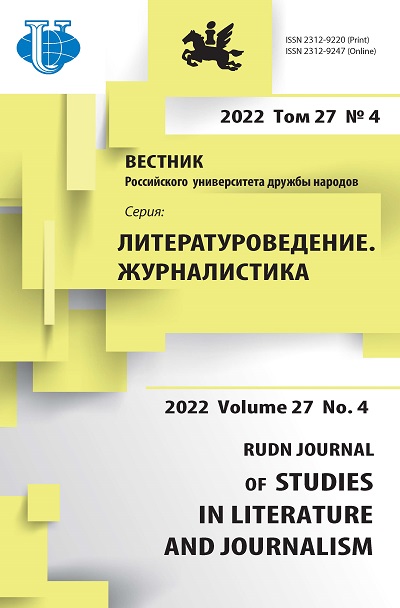Can Xue: the poetics of anti-aesthetics
- Authors: Tian F.1
-
Affiliations:
- Peoples’ Friendship University of Russia (RUDN University)
- Issue: Vol 27, No 4 (2022)
- Pages: 726-734
- Section: LITERARY CRITICISM
- URL: https://journals.rudn.ru/literary-criticism/article/view/33284
- DOI: https://doi.org/10.22363/2312-9220-2022-27-4-726-734
- ID: 33284
Cite item
Full Text
Abstract
Can Xue is a representative of Chinese women's literature of the late 20th and early 21st centuries. Her works are one of the most interesting literary phenomena. The author discusses the poetics of the “anti-aesthetics” in Can Xue’s works, based on the violation of classical aesthetic norms. To achieve a new aesthetic impact, Can Xue employs such artistic means as fantasy, metaphor, symbol, synesthesia in a new way. Possessing a rich and unbridled imagination, the writer strives to depict something that exists “in the zone of non-existence.” Besides, Can Xue creates anti-aesthetic, ugly, incomprehensible, and metaphorical images, invents illogical dialogues, refers to the phenomena of the interweaving of dreams and reality, peeping, etc. It is concluded that Can Xue breaks the frame of traditional aesthetic, seeks ugly, irrational, and unacceptable to popular standards of beauty. But despite all the ugliness, she draws attention to the hidden depths of human consciousness and soul, shows another truth of life. An analysis of the poetics of Can Xue allows a deeper and more comprehensive understanding of the writings of Chinese authors of the late 20th and early 21st centuries.
Keywords
About the authors
Fang Tian
Peoples’ Friendship University of Russia (RUDN University)
Author for correspondence.
Email: 1042205271@rudn.ru
ORCID iD: 0000-0002-3815-7084
postgraduate student, Department of Russian and Foreign Literature
6 Miklukho-Maklaya St, Moscow, 117198, Russian FederationReferences
- Chasygova, L.M., & Khadzieva, A.A. (2020). Dreams as a literary device in the works of Goncharova and Dostoevsky. International Scientific Journal, (1), 42–47. (In Russ.)
- Eidlin, L.Z. (1965). Pipa of Bo Juyi. Lyrics. Moscow: Khudozhestvennaya Literature Publ. (In Russ.)
- Hong, Zh. (2002). Focus on avant-garde literature. Novel Review, (2), 21–24. (In Chin.)
- Ivanov, V.I. (1974). Two elements in modern symbolism. Collected Works (vol. 2). Brussels: Foyer Oriental Chretien. (In Russ.)
- Khuziyatova, N.K. (2008). Kafkaesque motifs in the works of the modern Chinese writer Can Xue. Journal of the Buryat State University, (10), 244–248. (In Russ.)
- Nikitina, T.E. (2015). Synesthesia as an artistic technique in the works of Bunin. Language. Culture. Communications, (1). (In Russ.) Retrieved July 15, 2022, from https://journals.susu.ru/lcc/article/view/273/400
- Semenenko, I.I. (1979). Ode on the Lute of Ji Kang. Problems of Eastern Philology. Moscow: Moscow State University. (In Russ.)
- Sidorova, E.V., & Podshivalova, N.I. (2020). Alogisms in colloquial speech (based on stage dialogues of drama works). Philological Sciences. Questions of Theory and Practice, (1), 151–154. (In Russ.) http://doi.org/10.30853/filnauki.2020.1.30
- Toroptsev, S. (1990). Can Xue. Hut in the mountains. Asia and Africa Today, (12), 45–47. (In Russ.)
- Yusupova, G.A. (2021). The creative quest of Can Xue. O Literature. (In Russ.) Retrieved June 17, 2022, from http://literary.ru/literary.ru/readme.php?subaction=showfull&id=1611391239&archive
Supplementary files















